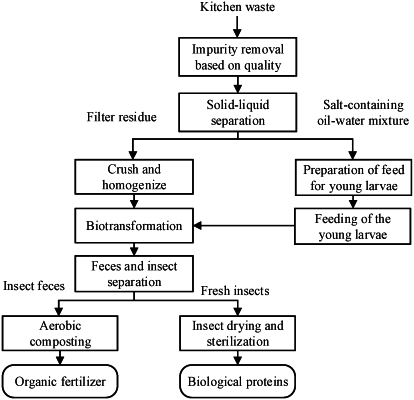| CPC C05F 17/05 (2020.01) [A01K 67/033 (2013.01); B09B 3/30 (2022.01); B09B 3/80 (2022.01)] | 7 Claims |

|
1. A method for fully recycling kitchen waste by using Hermetia illucens L. and aerobic microorganisms, comprising the following steps:
step 1: removing inert impurities in the kitchen waste by magnetic separation and separation by using a roller, and then performing solid-liquid separation to obtain kitchen waste filter residue and an oil-containing and salt-containing filtrate;
controlling a water content of the kitchen waste filter residue to be no more than 75% by pressure filtration, so that salinity is adjusted to 2.8%-3.2%, and an oil content is controlled at 2.6%-15%;
performing oil-water separation on the kitchen waste filter residue by standing separation, so that salinity of the oil-containing and salt-containing filtrate is controlled at 5.5%-6.5%, and an oil content is controlled at 3.4%-15%; and
then crushing and homogenizing the kitchen waste filter residue to form slurry with a particle size of 3-8 mm;
step 2: mixing wheat bran with the oil-containing and salt-containing filtrate to feed young larvae hatched from eggs, wherein a mass ratio of the oil-containing and salt-containing filtrate, the wheat bran, and the Hermetia illucens L. eggs is (32-35):(18-20):1, and a humidity of a mixed material is controlled at 60%-70%; and
feeding young larvae hatched from Hermetia illucens L. eggs with the mixed material for 5-7 days to obtain 2nd-3rd instar Hermetia illucens L. larvae; after the young larvae grow into the Hermetia illucens L. larvae, using the kitchen waste filter residue instead to feed the Hermetia illucens L. larvae evenly in batches at a ratio of correspondingly adding 900-1100 g of kitchen waste filter residue slurry to every gram of Hermetia illucens L. larvae every day, regularly exhausting and turning to control temperature and humidity, screening a mixture of the Hermetia illucens L. larvae and insect feces every day to obtain Hermetia illucens L. larvae and insect feces, and continuing to feed the Hermetia illucens L. larvae screened with the kitchen waste; and
step 3: sending the separated insect feces to an aerobic microbial degradation apparatus for aerobic composting to obtain an organic fertilizer; and after the Hermetia illucens L. larvae grow to the 5th-6th instars, screening out Hermetia illucens L. insects, and drying and sterilizing the Hermetia illucens L. insects to obtain dried insects.
|